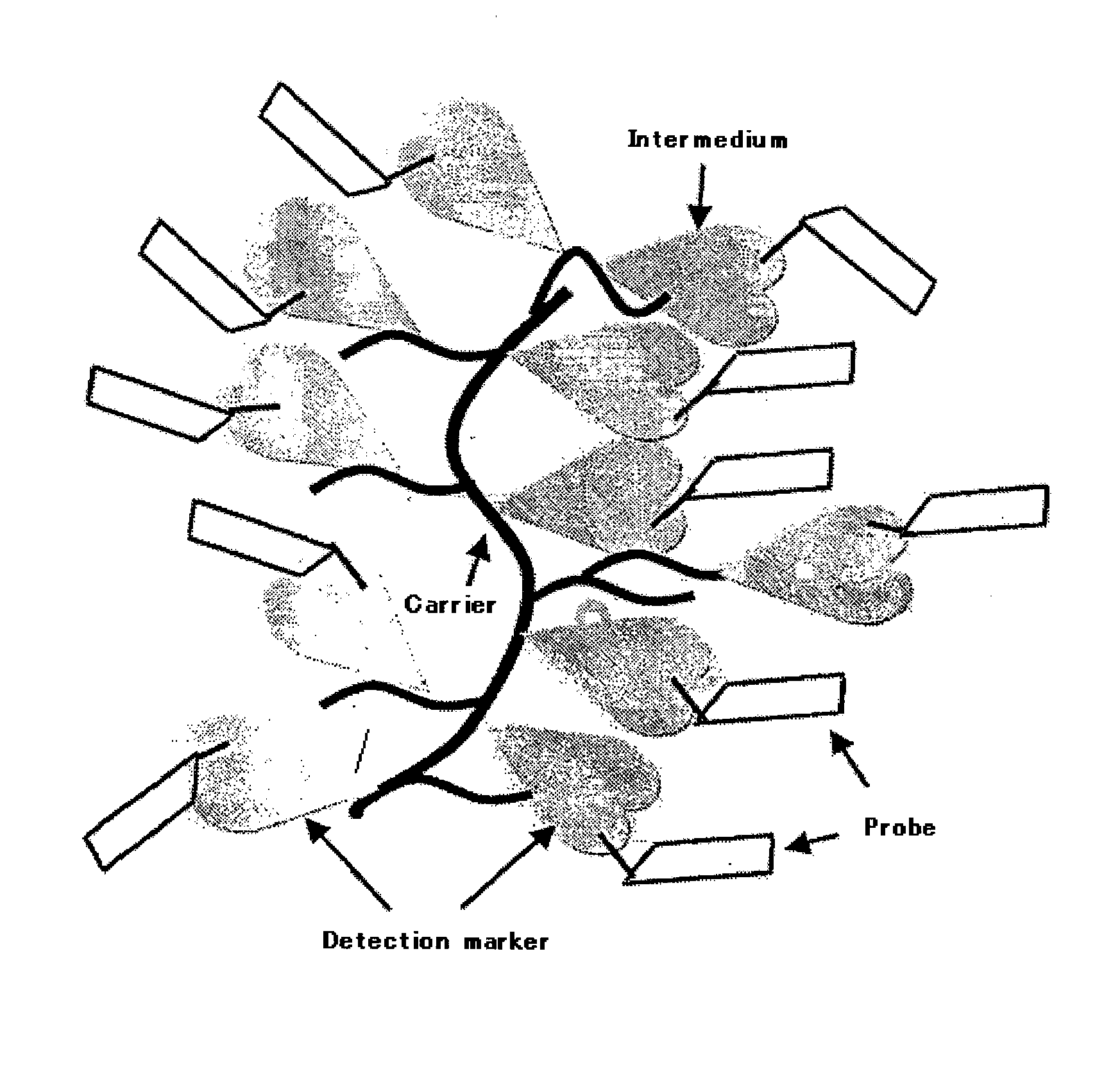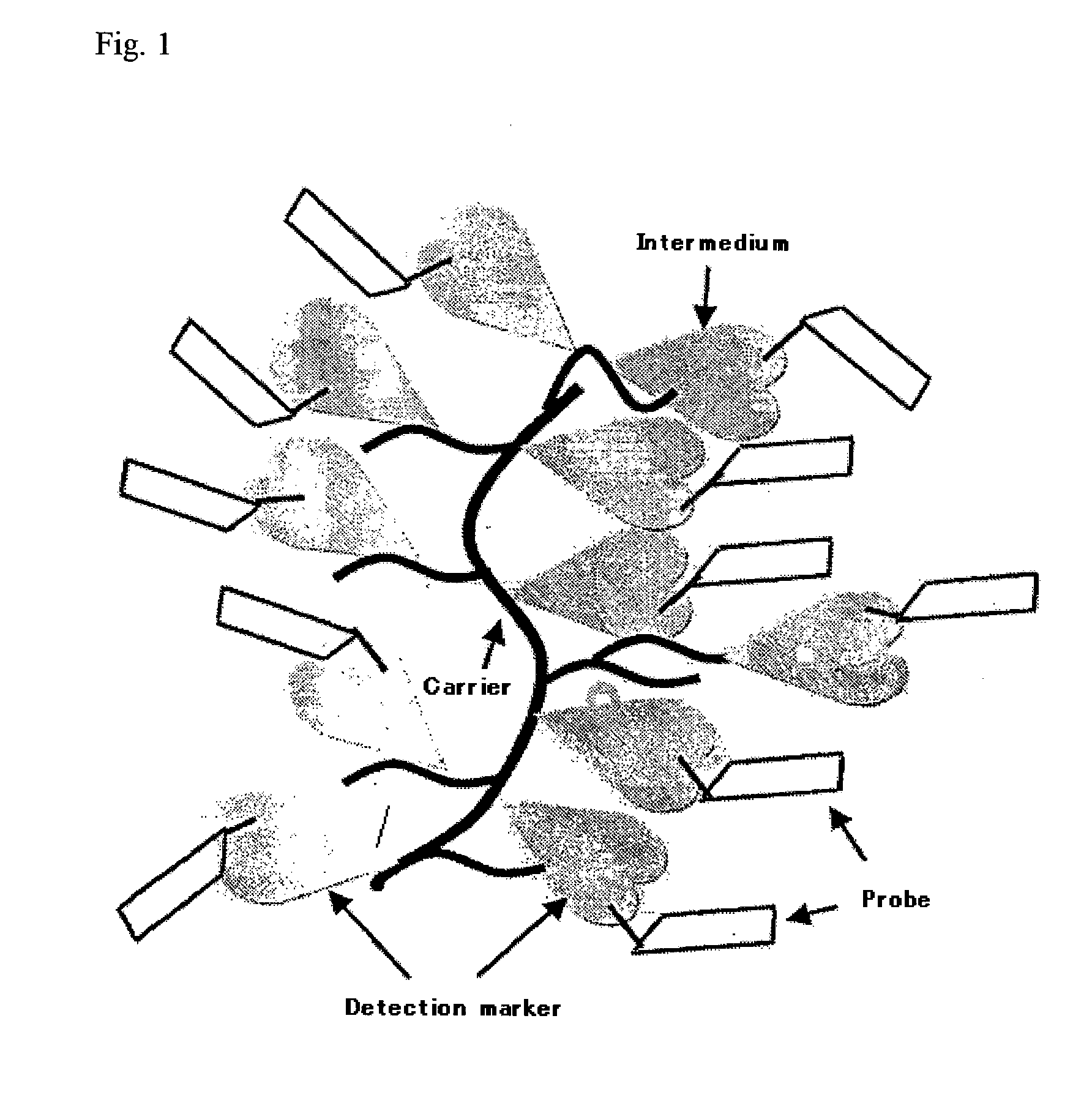Probe Complex
a technology of complexes and probes, applied in the field of probe complexes, can solve the problems of limited number of amino groups contained in antibodies and biotins that can be linked to antibodies, difficult general methods to detect trace substances in organisms, and high sensitivity of immunoassays, so as to reduce the total hydrophobicity, enhance sensitivity, and reduce non-specific reactions through hydrophobic bonds
- Summary
- Abstract
- Description
- Claims
- Application Information
AI Technical Summary
Benefits of technology
Problems solved by technology
Method used
Image
Examples
example 1
Preparation of Biotin-Anti HCV Core Antigen Monoclonal Antibody Complex with Ficoll 400 as a Carrier
[0045] 44 mg of Ficoll 400 (Amersham Bioscienses) was weighted and dissolved in 0.8 mL of 0.1M phosphate buffer (pH 7.0) and 0.4 mL of sodium periodate solution was added and mixed. After the incubation for two hours at room temperature, excess sodium periodate was removed by gel filtration (Sephadex G25, Amersham Bioscienses), Bovine Serum Albumin (BSA) solution was added and reacted for 3 hours at room temperature, and BSA was introduced into Ficoll. To stabilize the reaction product, Dimethylamine Borate (DMAB; Seikagaku Corporation) was added and mixed to react for 1 hour at room temperature, then Tris solution was added to block unreacted aldehyde groups on Ficoll. After overnight reaction at room temperature, the reaction product was purified by gel filtration (Sephacryl S300, 1.6*30) and absorbance at 280 nm was measured to calculate the concentration of carrier BSA conjugates...
example 2
Preparation of Biotinylated Anti-HCV Core Antigen Monoclonal Antibodies by a Conventional Method
[0046] Preparation of the biotinylated antibodies was performed according to the method described in a document attached to Sulfo-NHS-LC-Biotin (Pierce #21335). The Sulfo-NHS-LC-Biotin was mixed to anti-HCV core antigen monoclonal antibody in PBS (mixture of an equal amount of C11-14 IgG and C11-9 IgG), and was incubated for one hour at room temperature, excess Sulfo-NHS-LC-Biotin was then removed by gel filtration (Sephadex G25, Amersham Biosciences). The absorbance at 280 nm of biotinylated anti-HCV core antigen monoclonal antibodies was measured to calculate antibody concentration.
example 3
[0047] Comparison of the biotin-anti-HCV core antigen monoclonal antibody complexes were prepared in Example 1 with the biotinylated anti-HCV core antigen monoclonal antibodies were prepared by a conventional method in Example 2.
[0048] Anti-HCV core antigen monoclonal antibodies were adjusted to be 4 μg / mL with 0.1M acetate / 0.1M phosphate buffer (pH 4.8), 250 μl was added to each well of 96-well microplate, and each well was incubated overnight at 4 C.°. After washing with PBS, 350 μl of 0.5% casein was added to each well, and each well was incubated for three hours at room temperature. Recombinant HCV core antigens (c11) prepared to concentrations of 0 fmol / L, 148 fmol / L, 444 fmol / L, 1333 fmol / L, 4000 fmol / L, 12000 fmol / L and 36000 fmol / L were added as samples, and each well as incubated for one hour at room temperature with stirring. After washing six times with 10 mM phosphate buffer pH 7.3 containing 0.05% Tween 20 (washing solution). 200 μl each of the biotin-anti-HCV core ant...
PUM
| Property | Measurement | Unit |
|---|---|---|
| concentration | aaaaa | aaaaa |
| concentration | aaaaa | aaaaa |
| pH | aaaaa | aaaaa |
Abstract
Description
Claims
Application Information
 Login to View More
Login to View More - R&D
- Intellectual Property
- Life Sciences
- Materials
- Tech Scout
- Unparalleled Data Quality
- Higher Quality Content
- 60% Fewer Hallucinations
Browse by: Latest US Patents, China's latest patents, Technical Efficacy Thesaurus, Application Domain, Technology Topic, Popular Technical Reports.
© 2025 PatSnap. All rights reserved.Legal|Privacy policy|Modern Slavery Act Transparency Statement|Sitemap|About US| Contact US: help@patsnap.com


